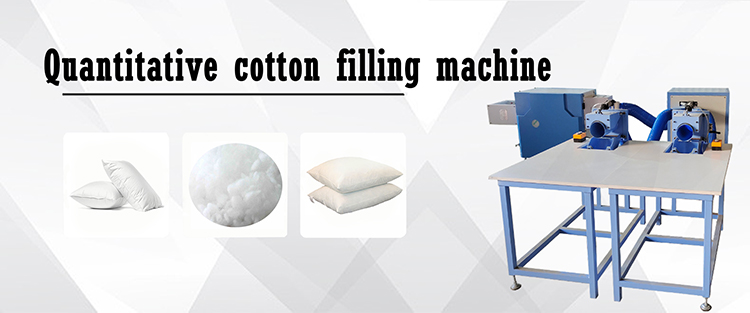How does a Quantitative Cotton Filling Machine achieve quantitative cotton filling?

In modern home textile, toy and automotive interior industries, large-scale, accurate and consistent filling is the key to improving product quality and production efficiency. Today, we will analyze in detail how a quantitative cotton filling machine can achieve quantitative cotton filling from principle to process.
1. Automatic cotton feeding and opening: Laying the foundation for Quantitative Cotton Filling Machine
Cotton feeding silo
Quantitative cotton filling machines are usually equipped with large-capacity silos to carry original cotton wool, down or other fiber fillings.
The silo is equipped with an adjustable door, and the initial feeding speed can be set according to the production requirements to ensure that there is continuous material and no material jam.
Opening system
In order to ensure that the filling volume and feel are consistent, the raw materials must first be opened into a fluffy state.
Through an efficient opener or opening roller, the fibers are disassembled and combed to eliminate fiber entanglement, making subsequent quantitative measurement more accurate.
2. Accurate measurement: electronic weighing VS volume measurement
Electronic weighing measurement
The overload sensor or weighing table monitors the weight of the silo in real time, and the system clearly reads the current material weight.
Through high-speed communication between PLC (programmable controller) and weighing module, the feed amount is dynamically corrected to ensure that the weight error of each discharge is controlled within ±1%.
Volumetric metering
Some Quantitative Fiber Stuffing Machine uses spiral conveyor or cam distributor to push a fixed volume of cotton wool to the discharge port according to the preset speed and angle.
Combined with the pre-calibrated volume-weight correspondence, a relatively stable quantitative effect is achieved, which is suitable for scenes with small changes in fiber density.
3. Filling mechanism: ensure uniformity and speed
Pneumatic filling
Use compressed air to quickly deliver the measured fiber into the pillowcase, cushion or doll body, and the filling speed can reach 3-5 seconds each time.
The pneumatic system pressure is adjustable, and it is matched with filling materials of different hardness and density to avoid over-tightness or voids.
Mechanical push
Use mechanical structures such as swing arms, pistons or rollers to push the fiber into the product along a fixed path.
Applicable to scenarios with strict requirements on filling path strength, such as multi-cavity pillow cores or complex doll structures.
4. Intelligent control: multi-program preset and real-time monitoring
PLC/touch screen operation
Multiple groups of product programs can be switched with one button to meet the Quantitative Pillow Filling Machine of different specifications and weights.
Display real-time weight, filling times, production speed and other data to facilitate quick adjustment by production supervisors.
Remote monitoring and alarm
Some high-end models support networking functions, and production data can be viewed through PC or mobile phone App, and parameters can be sent remotely.
When the cotton bin is insufficient, the pipeline is blocked or the metering is out of tolerance, the system will automatically alarm and suspend cotton filling to reduce the defective rate.
5. Core advantages: high efficiency, stability and cost saving Quantitative Pillow Stuffing Machine
| Advantages | Detailed description |
| High efficiency | Automatic cotton filling takes only 3-6 seconds on average each time, which is suitable for mass production; it reduces manual intervention and increases production capacity by more than 50%. |
| High consistency | Electronic weighing + intelligent feedback, with an error of <±1%, ensures that the weight and feel of each product are exactly the same, thus improving user satisfaction. |
| Save manpower | The whole process from raw material loosening, metering to filling is integrated, and 1-2 people can operate multiple devices, which significantly reduces labor costs. |
| Environmentally friendly cleaning | The closed structure and dust removal system can effectively suppress the flying of cotton wool, improve the workshop environment and reduce the occupational health risks of employees. |
6. Selection and application suggestions
Selection based on material characteristics
Lightweight and loose materials (polyester cotton, hollow cotton): electronic weighing models are preferred to ensure ultra-low error.
Material with large density fluctuations (down, pearl cotton): It is recommended to equip with capacitive material level detection, and support volume measurement + weighing double verification.
Configuration based on production capacity requirements
Small batch and multi-variety production: choose mid-to-high-end models with multiple program presets and flexible switching.
Large batch production: choose a continuous cotton filling machine with high speed, automatic feeding + automatic dust cleaning.
Post-maintenance and upgrade
Regularly calibrate the weighing system to maintain error control;
Clean the pipeline and filter element to prevent blockage;
Upgrade the control system software to achieve remote monitoring and data analysis.
From automatic opening, precise measurement to high-speed filling, Quantitative Fiber Filling Machine have become the core equipment on the production line of filling products such as pillows, cushions, toys and down jackets with their high efficiency, stability and consistency. When purchasing, factories should choose the most suitable cotton filling equipment based on their own output, material characteristics and automation level. If you need customized solutions or technical consultation.
Please feel free to contact us and we will tailor the best process for you!
Post time:2025-05-26
